The D&D dice you need (and don’t need) to get your tabletop RPG addiction rolling
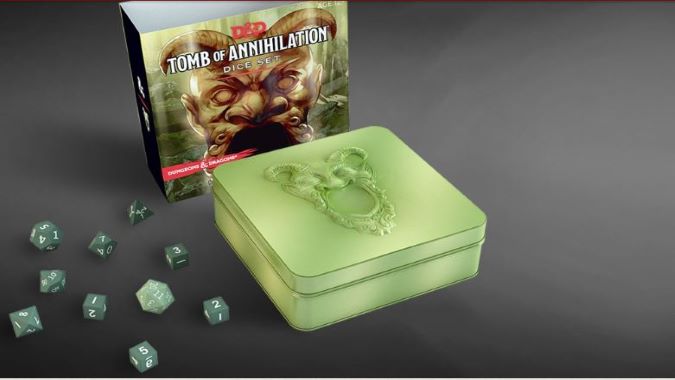
The greatest power in Dungeons and Dragons — in most tabletop roleplaying games — is the dice. They determine successes, failures, how much damage is dealt, even your characters’ ability scores before you start playing at all. Characters’ deaths are dictated by these little pieces of plastic and the numbers that they show.
While online dice rollers are a great invention in the age of social distancing, nothing gives players a sense of power like a handful of dice. There’s just something special about hearing the noise of dice scattering across the table and knowing that every number that lands face-up will be added together, resulting in pain against the enemy.
But what dice does a new player need to start D&D? What are the different types of dice? What does “polyhedral” even mean? Let’s take a basic look at the different dice, the terminology, and whether a new player really needs to invest money in them right away.
Note to Dungeon Masters: yes, you will need to buy dice right away, because you’ll be expected to have all the resources at the ready (in case your players don’t).
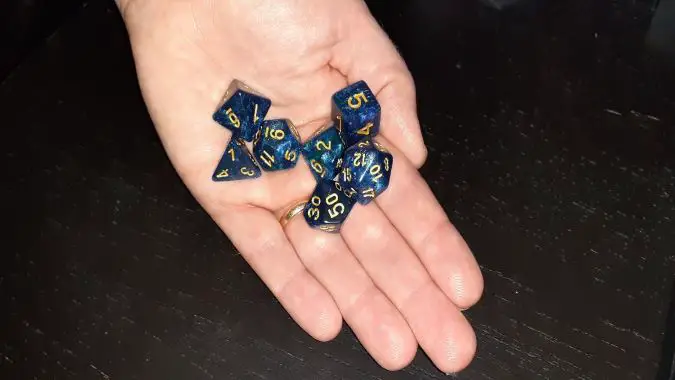
The basic terms of D&D dice
First of all, D&D dice is the correct term for these particular polyhedral dice. Polyhedral just means “many-sided 3D shape,” but when you bring D&D into the mix you’re talking about a specific set of polyhedral dice: a d20, d12, d10, d8, d6, d4, and d100. Even if you’re playing Pathfinder, D&D is the game that made these different-sided dice famous, so that’s how they’re usually referenced. If you want to search for them on the internet, or go into a local gaming store, that’s term to use.
The dice are so important — and referenced so often in the game — you’ll usually see them referenced as a lowercase “d.” The damage for the spell Fireball reads:
A target takes 8d6 fire damage on a failed save, or half as much damage on a successful one.
This notation is simple, but important, because it tells you exactly what you’re doing with your dice:
- Anytime the lowercase “d” with numbers around it shows up, dice are being rolled.
- The number after the d it shows what type of dice. In this case, a six-sided die.
- The number in front of of the d shows how many of that dice are being rolled. In this case, the damage of the Fireball being cast is the sum of eight six-sided dice.
This doesn’t necessarily mean you need eight six-sided die to play — simply that you need to roll eight times to calculate your damage. The total damage is a minimum of 8, if all the dice rolled revealed a 1, or a maximum of 48, if all the dice rolled their highest value, a 6. Realistically, it will always be somewhere in the middle.
Other key words that mean it is time to roll dice include: initiative, check, save, damage, heal, or restore.
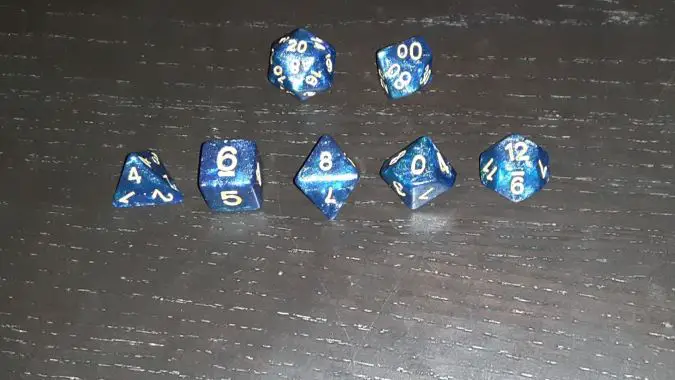
The different types of D&D dice
There are seven different dice, whose names generally correspond to how many sides the dice have — though there’s always an exception. Dice can have any function in the game, up to the DM’s whimsy. The DM could have six options for the group to encounter, ask someone to roll a d6, and let that be the decision maker. There could be a good/bad decision, and instead of flipping a coin, a d4 is rolled, odd for good, even for bad. Or, just to scare the group, the DM could roll a d20 and go on with no explanation at all. [Ed’s note: DMs are like that.]
However, each of the dice have a purpose that they are most commonly used for in D&D. Though every game uses dice a little differently, these are some rules of thumb for D&D.
The star of the show is the twenty-sided dice
In D&D, this is the dice you’ll roll the most. It’s the decision making dice. It determines who goes first in combat; whether a hit lands, misses, or crits; and to find out just how well your character performs different tasks. When a character investigates the ruins of a castle, a roll of the d20 can determine their knowledge of the site’s history, how much magical residue they find, or whether they can handle the animals that have taken over the remains of the place. A character knocked to 0 health in combat is reliant on the rolls of this dice to determine if they live or die.
In short, the d20 determines outcomes in D&D, sometimes with power over the DM.
The twenty-sided die really is unique among all the dice. Terms like Advantage (roll twice, take the higher number), Disadvantage (roll twice, take the lower number), and Crit (usually referring to rolling a 20, which has certain meanings in spells and abilities, and can only be activated when rolling a d20). This die will be rolled constantly in and out of combat: the other dice can’t make that claim.
Damage and healing dice
These are the d4, d6, d8, d10, and d12, all aptly named for the number of sides they have.
They tend to be rolled for damage, and occasionally for healing. As the campaign progresses, and characters grow stronger, the dice grow stronger. Numbers grow bigger, hence, more sides to the dice. The d4, the smallest, will tend to be used for a small bonus, an unarmed strike, or a low level spell learned early in the game. A d12 is more likely to represent the damage of a larger weapon mid-campaign, and used less frequently early on in the game. Later in the game, as powers and attacks increase, multiple dice will be added together, rather than larger dice rolled.
As characters level up, and health is gained at each level, the dice rolled to determine the increase in health is either a d8, d10, or d12, depending on the character’s class and level.
Of these dice, the one that is used the most in the early game is the d6. When creating a character, the player rolls d6’s to determine the starting ability score. The six-sided die is needed before the game even starts, to create the character. The DM at least will need a lot of these on hand to start the creation process.
The d100
The d100 is the exception to the dice naming rule, because it’s not a one hundred-sided dice: instead, it’s ten-sided. This dice is almost always rolled along with the d10 to reach a number between 1 and 100. The main purpose of this roll is usually a percentage. If there is treasure, what percent of the treasure did the party walk away with? If the party was performing for a crowd, what percentage the crowd did the party win over?
The other use for this is the Wild Magic Sorcerer. When this subclass of Sorcerer uses a spell, they roll a d20. On a 1, something random happens, based on a Wild Magic table of 1 to 100. Then these two dice are rolled.
Overall, a d100 is the least used of all the dice.
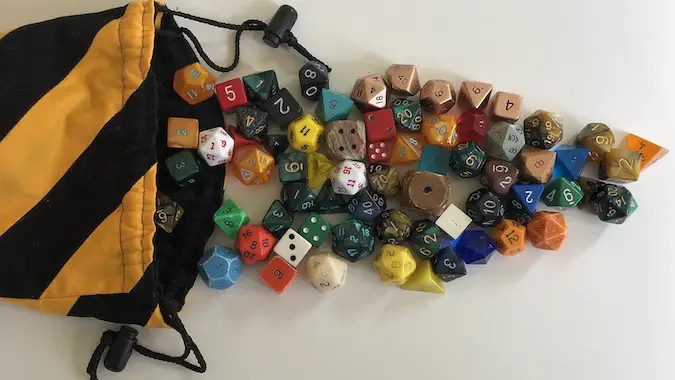
So, what dice do you need to start D&D?
For the first game, you will want to have your own d20. This is an important die, and you want one of your own. This will be used a lot, and there are only so many times you can ask others to borrow their dice.
This isn’t likely something you have lying around the house, so snag one of these ahead of time, or ask someone beforehand to borrow it for the whole game.
Next, get some six-sided dice. These are more useful than other dice in the beginning, and they’re very easy to find. You probably have them around your house: that box of Risk you don’t play because it takes two days? It has five d6 ready to steal. All those Monopoly games people give you as gifts, but you really only need one? They each have a pair of dice to take. It’s best to build up a whole collection of d6’s, the second most important dice in D&D.
For the first game, that’s all you need. The other dice are used infrequently in the low level game, if you are only playing once to try it, it probably is not worth dropping money on more.
If you are going to play a campaign for any longer, then it is highly recommended to buy a set of D&D dice which will include all seven of the dice noted above. On Amazon or in a game store, this can be found for as little as $10, so it isn’t a heavy investment.
One set can carry you all the way through a campaign: you won’t need anything more, though it’s highly recommended to have extra d6’s on hand. Remember Fireball! That needs 8d6 to cast. And while you could roll one d6 eight times, it just feels more powerful to roll eight at once.
When you get heavy into the game, you’ll want two d20’s, for when you roll with Advantage or Disadvantage. You’ll start to use abilities that have multiple d8’s, d10’s, or d12’s. Depending on class, some will use multiple d4’s. You’ll never need more than one d100.
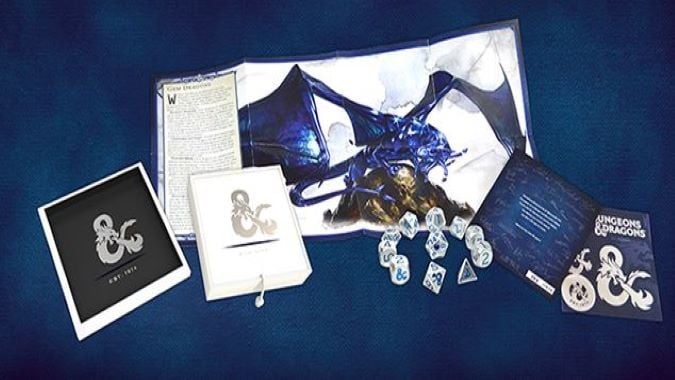
Expanding your dice collection
If you truly enjoy collecting dice, there are nearly an infinite number of colors and styles. Plastic is merely the start. You’ll find dice that are made of wood, metal, stone, and even pure gold. Then how you store your dice matters. You can throw them loosely in a box or bag, or store them in a box made specifically for dice, where they fit snugly in individual compartments. Both dice and cases come in every style and material you can imagine.
Dice collection can be a hobby of its own, that goes well beyond the games they are used for. There’s always another cool-looking dice to add to your collection — and it can be hard to stop collecting once you get started.
And this is all before starting down the path of making your own dice (if you’re the crafty sort). The options with dice are really endless.
So good luck starting your collection!
Please consider supporting our Patreon!
Join the Discussion
Blizzard Watch is a safe space for all readers. By leaving comments on this site you agree to follow our commenting and community guidelines.




